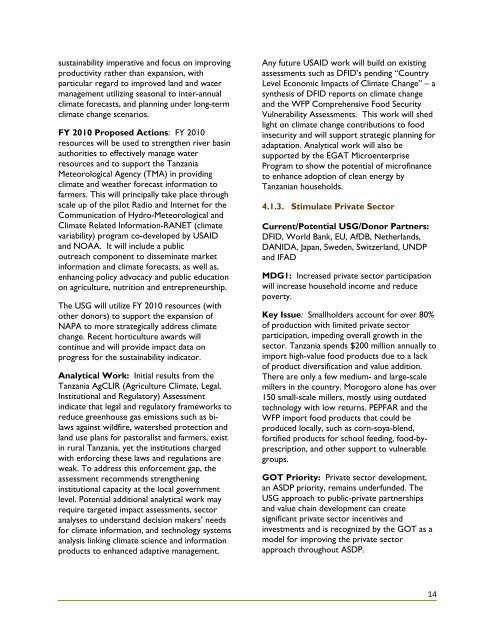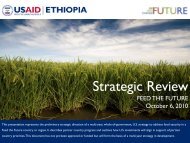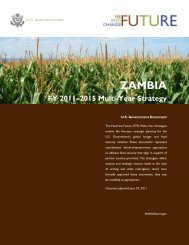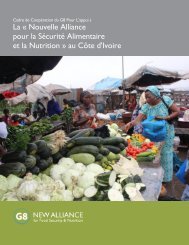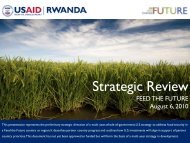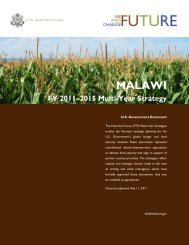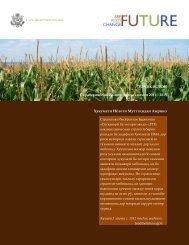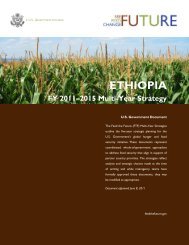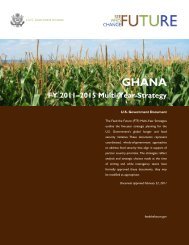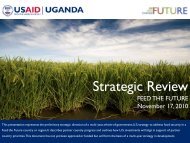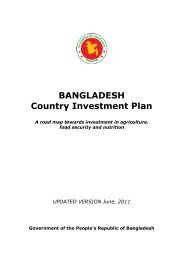Feed the Future FY 2010 Implementation Plan, Tanzania
Feed the Future FY 2010 Implementation Plan, Tanzania
Feed the Future FY 2010 Implementation Plan, Tanzania
- No tags were found...
You also want an ePaper? Increase the reach of your titles
YUMPU automatically turns print PDFs into web optimized ePapers that Google loves.
sustainability imperative and focus on improvingproductivity ra<strong>the</strong>r than expansion, withparticular regard to improved land and watermanagement utilizing seasonal to inter-annualclimate forecasts, and planning under long-termclimate change scenarios.<strong>FY</strong> <strong>2010</strong> Proposed Actions: <strong>FY</strong> <strong>2010</strong>resources will be used to streng<strong>the</strong>n river basinauthorities to effectively manage waterresources and to support <strong>the</strong> <strong>Tanzania</strong>Meteorological Agency (TMA) in providingclimate and wea<strong>the</strong>r forecast information tofarmers. This will principally take place throughscale up of <strong>the</strong> pilot Radio and Internet for <strong>the</strong>Communication of Hydro-Meteorological andClimate Related Information-RANET (climatevariability) program co-developed by USAIDand NOAA. It will include a publicoutreach component to disseminate marketinformation and climate forecasts, as well as,enhancing policy advocacy and public educationon agriculture, nutrition and entrepreneurship.The USG will utilize <strong>FY</strong> <strong>2010</strong> resources (witho<strong>the</strong>r donors) to support <strong>the</strong> expansion ofNAPA to more strategically address climatechange. Recent horticulture awards willcontinue and will provide impact data onprogress for <strong>the</strong> sustainability indicator.Analytical Work: Initial results from <strong>the</strong><strong>Tanzania</strong> AgCLIR (Agriculture Climate, Legal,Institutional and Regulatory) Assessmentindicate that legal and regulatory frameworks toreduce greenhouse gas emissions such as bilawsagainst wildfire, watershed protection andland use plans for pastoralist and farmers, existin rural <strong>Tanzania</strong>, yet <strong>the</strong> institutions chargedwith enforcing <strong>the</strong>se laws and regulations areweak. To address this enforcement gap, <strong>the</strong>assessment recommends streng<strong>the</strong>ninginstitutional capacity at <strong>the</strong> local governmentlevel. Potential additional analytical work mayrequire targeted impact assessments, sectoranalyses to understand decision makers’ needsfor climate information, and technology systemsanalysis linking climate science and informationproducts to enhanced adaptive management.Any future USAID work will build on existingassessments such as DFID’s pending “CountryLevel Economic Impacts of Climate Change” – asyn<strong>the</strong>sis of DFID reports on climate changeand <strong>the</strong> WFP Comprehensive Food SecurityVulnerability Assessments. This work will shedlight on climate change contributions to foodinsecurity and will support strategic planning foradaptation. Analytical work will also besupported by <strong>the</strong> EGAT MicroenterpriseProgram to show <strong>the</strong> potential of microfinanceto enhance adoption of clean energy by<strong>Tanzania</strong>n households.4.1.3. Stimulate Private SectorCurrent/Potential USG/Donor Partners:DFID, World Bank, EU, AfDB, Ne<strong>the</strong>rlands,DANIDA, Japan, Sweden, Switzerland, UNDPand IFADMDG1: Increased private sector participationwill increase household income and reducepoverty.Key Issue: Smallholders account for over 80%of production with limited private sectorparticipation, impeding overall growth in <strong>the</strong>sector. <strong>Tanzania</strong> spends $200 million annually toimport high-value food products due to a lackof product diversification and value addition.There are only a few medium- and large-scalemillers in <strong>the</strong> country. Morogoro alone has over150 small-scale millers, mostly using outdatedtechnology with low returns. PEPFAR and <strong>the</strong>WFP import food products that could beproduced locally, such as corn-soya-blend,fortified products for school feeding, food-byprescription,and o<strong>the</strong>r support to vulnerablegroups.GOT Priority: Private sector development,an ASDP priority, remains underfunded. TheUSG approach to public-private partnershipsand value chain development can createsignificant private sector incentives andinvestments and is recognized by <strong>the</strong> GOT as amodel for improving <strong>the</strong> private sectorapproach throughout ASDP.14


